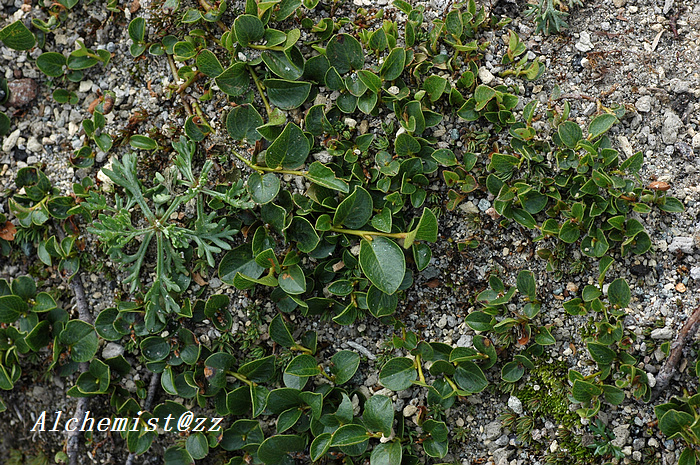- Scientific Name: Salix rotundifolia Trautv.
- Ref: Nouv. Mém. Soc. Imp. Naturalistes Moscou 2:304. 1832
- Synonyms: Salix leiocarpa (Cham.) Coville, Salix polaris var. leiocarpa Cham.
- English Common Name: least willow
- Chinese Common Name: 圆叶柳 yuányè∙liǔ
- Japanese Common Name: マメヤナギ [豆柳] mameyanagi
- Family: Salicaceae
- Genus: Salix
- Distribution: North America and East Asia
- Photo: Mt. Changbai, Jilin
Plants 0.005-0.05 m, (dwarf), forming clones by rhizomes. Stems erect; branches yellow-green, yellow-brown, or gray-brown, glabrous; branchlets yellow-brown or red-brown, glabrous; branches and branchlets sometimes weakly glaucous. Leaves (marcescent but not skeletonized), stipules usually absent or rudimentary, rarely present on late ones; petiole (convex, or shallowly to deeply grooved, flat), 0.4-4.6(-5.5) mm, (glabrous adaxially); largest medial blade (2 pairs of secondary veins arising at or close to base, arcing toward apex) broadly elliptic, subcircular, or circular, 1.9-16.3 × 3-10.5 mm, 0.84-1.17(-2.53) times as long as wide, base rounded or convex, margins flat, entire, ciliate, apex retuse, rounded, convex, or acute, abaxial surface glabrous, adaxial highly glossy, glabrous; proximal blade margins entire; juvenile blade glabrous or puberulent. Catkins from subterminal buds; staminate subglobose, stout, or indeterminate, 3.3-18.5 × 2.5-12 mm, flowering branchlet 0.5-9 mm; pistillate moderately densely to loosely flowered (2-15 flowers), stout, subglobose, globose, or indeterminate, 4.5-35 × 2-17 mm, flowering branchlet 0.5-22 mm; floral bract brown, 1.6-2.8 mm, apex rounded or retuse, entire, abaxially sparsely hairy or ciliate, hairs usually wavy, crinkled or curly, rarely straight. Staminate flowers: abaxial nectary 0.5-1 mm, adaxial nectary narrowly oblong or oblong, 0.8-1.4 mm, nectaries distinct; filaments distinct or connate less than 1/2 their lengths, glabrous; anthers ellipsoid or globose, 0.4-0.6 mm. Pistillate flowers: abaxial nectary present or absent, adaxial nectary usually narrowly oblong or oblong, sometimes flask-shaped, 0.8-2 mm, longer than stipe; stipe 0.4-0.8 mm; ovary pyriform, glabrous or puberulent, (hairs in patches, especially on beak), beak slightly bulged below styles; ovules 7-17 per ovary; styles connate or slightly distinct distally, 0.5-1 mm; stigmas flat, abaxially non-papillate with pointed tip, or slenderly or broadly cylindrical, 0.28-0.6 mm. Capsules 3.8-8.3 mm. (Flora of North America, Vol. 7)
